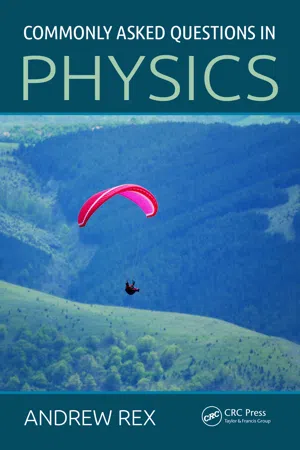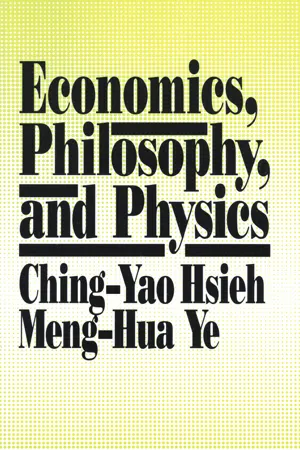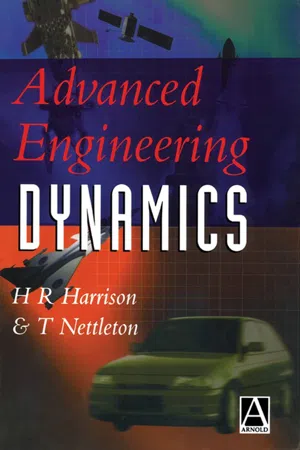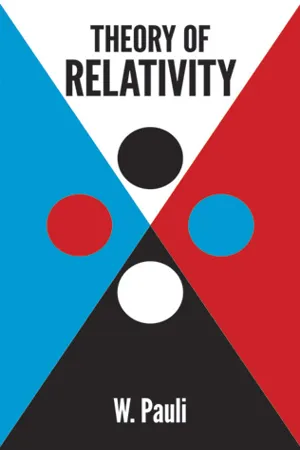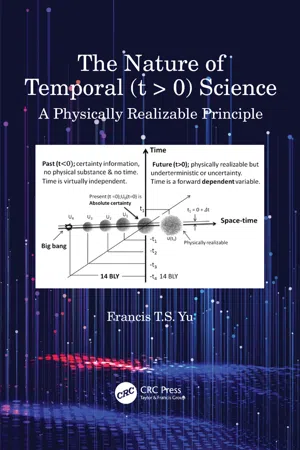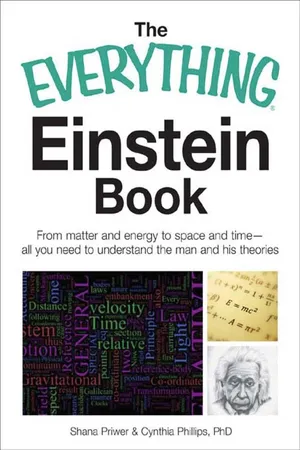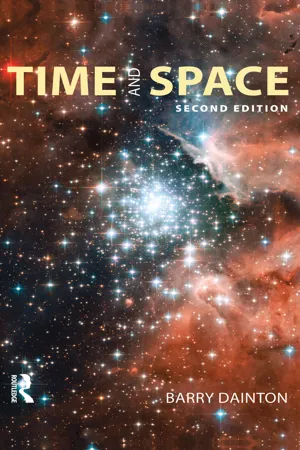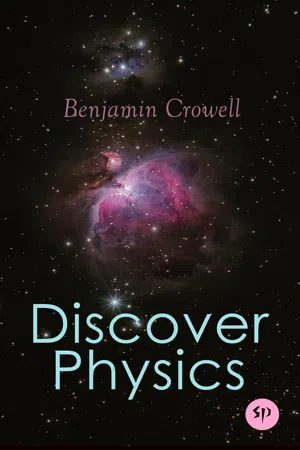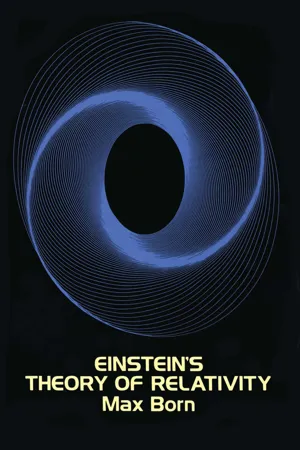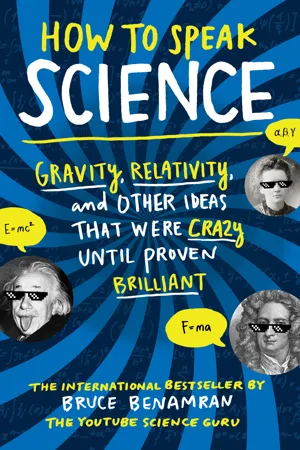Physics
Special Relativity
Special relativity is a fundamental theory in physics developed by Albert Einstein. It describes the behavior of objects moving at high speeds and the relationship between space and time. Key concepts include time dilation, length contraction, and the famous equation E=mc^2, which relates energy and mass. This theory revolutionized our understanding of the universe and has numerous practical applications.
Written by Perlego with AI-assistance
Related key terms
11 Key excerpts on "Special Relativity"
- eBook - ePub
- Andrew Rex(Author)
- 2014(Publication Date)
- CRC Press(Publisher)
Chapter 9 Relativity Relativity is one of the most important and fascinating fields of study within physics. It’s generally split into two subfields—Special Relativity and general relativity—both of which were developed by Albert Einstein in the early twentieth century. Relativity accounts for how events are viewed from different frames of reference, when those frames of reference are moving with respect to one another or in strong gravitational fields. It also accounts for how light will appear to observers in different frames of reference. Many of the effects predicted by the theory of relativity are contrary to the predictions of classical physics and to perceptions based on everyday experience. These striking and sometimes shocking predictions have been verified repeatedly by experimental evidence. Probably the most famous prediction of Special Relativity is the equivalence of mass and energy, expressed in the formula E = mc 2. This equivalence manifests itself in many ways, particularly in atomic and nuclear physics (Chapter 7) and in the study of fundamental particles (Chapter 8). The implications are far reaching and include the production of nuclear energy and nuclear weapons. What’s the Difference between Special Relativity and General Relativity? Special Relativity accounts for how material objects and light are viewed by observers traveling in different frames of reference, in constant, nonaccelerated motion with respect to one another. The fact that the speed of light is the same for observers in all reference frames is of fundamental importance. It leads to correct predictions about how the different observers measure the positions, lengths, and velocities of objects, and how they measure the passage of time - eBook - ePub
- Ching-Yao Hsieh, Meng-Hua Ye(Authors)
- 2016(Publication Date)
- Routledge(Publisher)
In the words of Prigogine and Stengers, “The fact that relativity is based on a constraint that applies only to physically localized observers, to beings who can be in only one place at a time and not everywhere at once, gives this physics a ‘human’ quality. . . . It is a physics that presupposes an observer situated within the observed world.” 10 In other words, it changes man’s dialog with nature. Since every reference system (or coordinate system) has its own particular time, there is no such thing as a space interval independent of time. Thus, Einstein’s special theory also revolutionized our concepts of space and time. We must accept that time is not independent of space, but is combined with it to form a four-dimensional space-time. The fundamental concept in relativity theory is an event, which is specified not only by space but also by a time of happening. To recapitulate, Einstein’s new universal constant has displaced four absolute concepts of classical physics: absolute space, absolute time, invariant speed of propagation, and absolute simultaneity. In addition, it has put an end to the claim to universality of Newtonian physics. Relativity, however, does not mean abandonment of the quest for absolute laws of physics. In Bertrand Russell’s words: physics is intended to give information about what really occurs in the physical world, and not only about the private perceptions of separate observers - eBook - ePub
- H. Harrison, T. Nettleton(Authors)
- 1997(Publication Date)
- Butterworth-Heinemann(Publisher)
9Relativity
9.1 Introduction
In this chapter we shall reappraise the foundations of mechanics taking into account Einstein’s special theory of relativity. Although it does not measurably affect the vast majority of problems encountered in engineering, it does define the boundaries of Newtonian dynamics. Confidence in the classical form will be enhanced as we shall be able to quantify the small errors introduced by using Newtonian theory in common engineering situations.The laser velocity transducer employs the Doppler effect which, for light, requires an understanding of Special Relativity. The form of the equations derived for cases where the velocities of the transmitter and/or the receiver are small compared with that of the signal is the same for both sound and light. This will be discussed later.We shall also consider the definition of force. It is of note that relativistic definitions are such that they encompass the Newtonian. The general theory of relativity raises some interesting questions regarding the nature of force, but these do not materially affect the equations of motion already derived.9.2 The foundations of the special theory of relativity
It is not our intention to retrace the steps leading to the theory other than to mention the most significant milestones. In the same way that Isaac Newton crystallized the laws of mechanics which have formed the basis for the previous chapters in this book, Albert Einstein provided the genius that solved the riddle of the constancy of the speed of light.James Clerk Maxwell’s equations for electrodynamics predicted that all electromagnetic waves travelled at a constant speed in a vacuum. If the value of the speed of light, c - eBook - ePub
- W. Pauli(Author)
- 2013(Publication Date)
- Dover Publications(Publisher)
PART I. THE FOUNDATIONS OF THE SPECIAL THEORY OF RELATIVITY1. Historical background (Lorentz, Poincaré, Einstein)The transformation in physical concepts which was brought about by the theory of relativity, had been in preparation for a long time. As long ago as 1887, in a paper still written from the point of view of the elastic-solid theory of light, Voigt1 mentioned that it was mathematically convenient to introduce a local time t' into a moving reference system. The origin of t' was taken to be a linear function of the space coordinates, while the time scale was assumed to be unchanged. In this way the wave equationcould be made to remain valid in the moving reference system, too. These remarks, however, remained completely unnoticed, and a similar transformation was not again suggested until 1892 and 1895, when H. A. Lorentz2 published his fundamental papers on the subject. Essentially physical results were now obtained, in addition to the purely formal recognition that it was mathematically convenient to introduce a local time t' in a moving coordinate system. It was shown that all experimentally observed effects of first order in υ/c (ratio of the translational velocity of the medium to the velocity of light) could be explained quantitatively by the theory when the motion of the electrons embedded in the aether was taken into account. In particular, the theory gave an explanation for the fact that a common velocity of medium and observer relative to the aether has no influence on the phenomena, as far as quantities of first order are concerned.3However, the negative result of Michelson’s interferometer experiment4 , concerned as it was with an effect of second order in υ/c, created great difficulties for the theory. To remove these, Lorentz5 and, independently, FitzGerald put forward the hypothesis that all bodies change their dimensions when moving with a translational velocity υ. This change of dimension would be governed by a factor κ √[1 − (υ2 /c2 ] in the direction of motion, with κ as the corresponding factor for the transverse direction; κ itself remains undetermined. Lorentz justified this hypothesis by pointing out that the molecular forces might well be changed by the translational motion. He added to this the assumption that the molecules rest in a position of equilibrium and that their interaction is purely electrostatic. It would then follow from the theory that a state of equilibrium exists in the moving system, provided all dimensions in the direction of motion are shortened by a factor √[1 − (υ2 /c2 ], with the transverse dimensions unaltered. It now remained to incorporate this “Lorentz contraction” in the theory, as well as to interpret the other experiments6 which had not succeeded in showing the influence of the earth’s motion on the phenomena in question. There was first of all Larmor who, as early as 1900, set up the formulae now generally known as the Lorentz transformation, and who thus considered a change also in the time scale7 . Lorentz’s review article8 , completed towards the end of 1903, contained several brief allusions which later proved very fruitful. He conjectured that if the idea of a variable electromagnetic mass was extended to all ponderable matter, the theory could account for the fact that the translational motion would produce only the above-mentioned contraction and no other effects, even in the presence of molecular motion. This would also explain the Trouton and Noble experiment. In addition, he raised the important question whether the size of the electrons might be changed by the motion.9 However, in the introduction to his article, Lorentz still maintained the principle that the phenomena depended not only on the relative motion of the bodies, but also on the motion of the aether.9a - eBook - ePub
The Nature of Temporal (t > 0) Science
A Physically Realizable Principle
- Francis T.S. Yu(Author)
- 2022(Publication Date)
- CRC Press(Publisher)
Eq. (5.3) . It is, however, correctly treated special theory as a directional sensitive theory because a particle in motion follows its velocity vector. From this we see that the relativistic distance between two particles on the “same direction” can be shown as:From this the faster particle has a section of time-gain relative to the slower one as given by:(5.9)d r=(Δ t ′ ,)v 1–v 2v 1>v 2For example, the distance between San Diego and New York City is:Δ t ′′ =(5.10)(Δ t ′ ,1 –)v 2/v 1v 1>v 2and we have the following relationship:d = c Δ t ′(5.11)Δ t ′′ =(5.12)(d / c ,1 –)v 2/v 1v 1>v 2this represents a section of time-gain of a faster aircraft with respect to the slower aircraft between a distance d, but it is not a section of time-gain with respect to the universe since the time within an aircraft is the same as any subspace within our universe. Again, we see that we can change the relative arrival time between the two aircrafts, but we cannot change the time within our universe.Although Einstein's special theory fails to legitimize within our temporal (t > 0) universe, yet his special theory had produced one of the most relevant energy equations as given by:E =(5.13)Mc 2where E is energy, M is mass, and c is the velocity of light. From this we see that our current science is limited by the speed of light. The fact is that Einstein's energy equation had given us the fundamental limit of energy; that is, mass and energy are equivalent. In this one of most famous and important equations that more than haft the world's population may have known it but many of them may not actually understand its physical significance. Anyway, this equation strictly speaking it is not consistent with a physically realizable axiom of our temporal (t > 0) universe since the special theory was developed from a non-physically realizable paradigm as I had shown. Yet the physical significance of Einstein's energy equation remains; energy and mass are equivalent. - eBook - ePub
The Everything Einstein Book
From Matter and Energy to Space and Time, All You Need to Understand the Man and His Theories
- Shana Priwer, Cynthia Phillips(Authors)
- 2011(Publication Date)
- Everything(Publisher)
Chapter 6Special Relativity
T he second of Einstein’s trio of groundbreaking 1905 papers was called “The Electrodynamics of Moving Bodies.” The paper was originally intended to discuss some inconsistencies in Maxwell’s theory of electromagnetic radiation. In fact, as it turned out, Einstein’s discoveries would yet again shake the laws of physics, this time disrupting Newton’s orderly view of the universe with a completely new conception of space and time.Classical Physics
Physics, at the beginning of the twentieth century, was an orderly subject as developed over the previous centuries. The views of space and time in physics were based primarily on work done by Galileo and Newton, and this work was disrupted by Einstein’s new revelations. Almost in passing, Einstein also proved the nonexistence of an odd facet of nineteenth-century science, the “ether.”The Ether
Einstein’s work on relativity disrupted the prevailing nineteenth-century view of the medium through which light, and other electromagnetic radiation, traveled. Scientists had known for some time that sound waves were compressional waves, which can only travel through a medium such as air, water, wood, or some other material. This material is what does the “waving”–the vibration of the material, causing it to contract and expand as the energy of the sound wave moves through it, is what transmits the wave.Contrary to what’s seen in most science fiction movies, since space is a vacuum, no sound is transmitted in space! Starships don’t make a “whooshing” sound as they go by. The movie 2001: A Space Odyssey was one of the few movies to accurately depict the silence of space.Since sound waves required a medium to travel in, scientists of the nineteenth century assumed that light required such a medium as well. It was known that light could travel through a vacuum; therefore, scientists proposed that light traveled in an undetectable medium called the “ether.” In fact, different ethers were proposed as the means of travel for a variety of waves, including light, heat, electricity, and magnetism. - eBook - ePub
- Barry Dainton(Author)
- 2016(Publication Date)
- Routledge(Publisher)
18 Special Relativity 18.1 Time, space and Einstein Our investigations up to this point have not been in vain – they have certainly led us to a deeper understanding of the complexities of the issues we are concerned with – but they have also been inconclusive. Very different accounts of the large-scale structure of time seem both metaphysically viable and compatible with the character of our everyday experience. Space has proved an equally stubborn topic. Substantivalism may be ahead on points in certain respects, but there have been few clear-cut victories. But for those looking for definite answers all is not yet lost. We have yet to consider the impact of more recent scientific developments, and some believe that answers to the questions we have been considering can be found here. Of course, these answers will only concern the space and time of our world, rather than space and time in general, but being so restricted would scarcely reduce their interest. However, although contemporary science has a great deal to teach us, anyone looking for definitive answers to our questions will be disappointed. Our current best theory of the very small – quantum theory – and our current best theory of the very large – Einstein's general theory of relativity (GTR) – have yet to be reconciled, and there is no consensus among the physicists working in these areas as to what the overall character of theory that synthesizes the two, "quantum gravity", will be. Some believe that the successor theory will retain the most distinctive features of both relativity and quantum theory; others believe that at least some of these features will disappear. The waters are further muddied by the fact that there are continuing disputes over the correct interpretation of relativity and quantum theory themselves. As a consequence, much of what we can learn about our space and time from current physics can only have a provisional status - eBook - ePub
- Benjamin Crowell(Author)
- 2018(Publication Date)
- Studium Publishing(Publisher)
How did Einstein explain this strange refusal of light waves to obey the usual rules of addition and subtraction of velocities due to relative motion? He had the originality and bravery to suggest a radical solution. He decided that space and time must be stretched and compressed as seen by observers in different frames of reference. Since velocity equals distance divided by time, an appropriate distortion of time and space could cause the speed of light to come out the same in a moving frame. This conclusion could have been reached by the physicists of two generations before, but the attitudes about absolute space and time stated by Newton were so strongly ingrained that such a radical approach didn’t occur to anyone before Einstein.6.2 Distortion of Time and Space
Time
Consider the situation shown in figure b. Aboard a rocket ship we have a tube with mirrors at the ends. If we let off a flash of light at the bottom of the tube, it will be reflected back and forth between the top and bottom. It can be used as a clock; by counting the number of times the light goes back and forth we get an indication of how much time has passed: up-down up-down, tick-tock tick-tock. (This may not seem very practical, but a real atomic clock works on essentially the same principle.) Now imagine that the rocket is cruising at a significant fraction of the speed of light relative to the earth. Motion is relative, so for a person inside the rocket, b/1, there is no detectable change in the behavior of the clock, just as a person on a jet plane can toss a ball up and down without noticing anything unusual. But to an observer in the earth’s frame of reference, the light appears to take a zigzag path through space, b/2, increasing the distance the light has to travel.b / A light beam bounces between two mirrors in a spaceship.If we didn’t believe in the principle of relativity, we could say that the light just goes faster according to the earthbound observer. Indeed, this would be correct if the speeds were much less than the speed of light, and if the thing traveling back and forth was, say, a ping-pong ball. But according to the principle of relativity, the speed of light must be the same in both frames of reference. We are forced to conclude that time is distorted, and the light-clock appears to run more slowly than normal as seen by the earthbound observer. In general, a clock appears to run most quickly for observers who are in the same state of motion as the clock, and runs more slowly as perceived by observers who are moving relative to the clock. - eBook - ePub
- Max Born(Author)
- 2012(Publication Date)
- Dover Publications(Publisher)
Later, it is true, we shall see that the general theory of relativity of Einstein also regards systems as equi-valent which are accelerated with respect to each other, but in a sense which requires more detailed discussion. When dealing with this more general standpoint we shall return to the clock paradox and show that on close examination there are no difficulties in it. For in the considerations above we made the assumption that for sufficiently long journeys the short periods of acceleration exert no influence on the beating of the clocks. But this holds only when we are judging things from the inertial system A and not for the measurement of time in the accelerated system B. According to the principles of the general theory of relativity, gravitational fields occur in the latter which affect the beating of the clocks. When this influence is taken into account, it is found that under all circumstances B ′s clock goes in advance of A's, and thus the apparent contradiction vanishes (see VII, 11, p. 354). The relativization of the concepts of length and intervals of time appears difficult to many, but probably only because it is strange. The relativization of the concepts “below” and “above” which occurred through the discovery of the spherical shape of the earth probably caused people of that period no less difficulty. In this case, too, the result of research contradicted a view that had its source in direct experience. Similarly, Einstein's relativization of time seems not to be in accord with the experience of the time of the individual. For the feeling of “now” stretches without limit over the world, linking all being with the ego. The fact that the same moments that the ego experiences as “simultaneous” are to be called “consecutive” by another ego cannot be comprehended in fact by the actual experience of time. But exact science has other criteria of truth - eBook - ePub
- A. L. Stanford, J. M. Tanner(Authors)
- 2014(Publication Date)
- Academic Press(Publisher)
In this chapter we have described numerous physical phenomena predicted by the special theory of relativity, phenomena that cannot be explained by the classical mechanics of Newton. We have seen that relativistic mechanics does not contradict the validity of classical mechanics in the realm of speeds that are small compared to the speed of light, in those situations for which classical mechanics has been tested successfully for centuries. In fact, we have seen that the mechanics of relativity becomes identical to classical mechanics for speeds that are vanishingly small. Thus the theory of relativity generalizes classical mechanics: Relativity extends the range of validity of mechanics to include speeds that are comparable to the speed of light. The results of this extension, as we have seen, are often contrary to our experience and our physical intuition. Just as we do for any proposed physical theory, we expect experimental confirmation of the theory of relativity before we accept it as an appropriate description of nature.Experimental Confirmation of Time Dilation
Perhaps the most direct experimental confirmation of the time dilation predicted by the theory of relativity has been accomplished using extremely accurate chronometers, which are sometimes called “atomic clocks.” A cesium clock is a device that has a timekeeping precision of better than one part in 1 billion, a precision corresponding to an error of 1 second in about 30 years. Such devices were placed in airplanes that circled the earth. The time intervals indicated by the airborne clocks were then compared to those of another cesium clock fixed on the earth. Appropriate corrections were made for the effects of gravity and for the fact that neither of the clocks was in an inertial frame. The corrected difference in the time intervals measured by the “moving” and “stationary” clocks was predicted, according to relativistic time dilation, to be about 3 × 10−7 s. The measured time difference agreed with the theoretical prediction within an experimental error of about 0.2 × 10−7 - eBook - ePub
How to Speak Science
Gravity, Relativity, and Other Ideas That Were Crazy Until Proven Brilliant
- Bruce Benamran(Author)
- 2018(Publication Date)
- The Experiment(Publisher)
reproduce its cause—in that case, you’re in a cycle of cause and effect—but it’s never ever possible for an effect to influence its own cause ahead of time. With Einstein’s theory, where the speed of light is constant regardless of the reference frame, we have to add another item: There cannot be less time between a cause and its effect than the time that would be needed for light to travel between the location of the cause and the location of the effect.Einstein started out with the idea that nothing was necessary or absolute. And from there, brick by brick, he built a new theory of space and time. The first brick he would lay was the only absolute in his framework: The speed of light in a vacuum is absolutely constant, regardless of the reference frame. To explain all the behaviors associated with light, as well as other discoveries—namely, the contraction of electrostatic fields—Einstein used the concepts of length contraction , time dilation , and relativity of simultaneity . His theory was absolutely airtight and completely consistent with results from electromagnetism and classical mechanics. The introduction is over. Let’s go!Einstein, the ScammerLet’s take another little detour to discuss something that’s been going around ever since the internet became available to everyone everywhere. It’s the idea that “they’re lying to us.” Some gullible internet users183 are quick to believe the theories they find on the internet, even the craziest ones. These simple souls think they’re in on some big secret—it doesn’t bother them at all, it doesn’t even occur to them, that literally millions are in on the “secret” too. But, whatever. Some of the secret theories out there are rather famous—for instance, the idea that man never walked on the moon because Stanley Kubrick was commissioned by NASA to create the images. Folks, this theory was started as an April Fool’s joke.184 And then there’s the one about Einstein. According to this theory, Einstein wasn’t particularly bright, and apparently, he abused his position in the patent office to steal the special theory of relativity from Poincaré—little does it matter that Poincaré never submitted a patent application to Bern. Someone started this theory because, just because, Einstein “didn’t happen to be” in academia and was a complete unknown before he shared his ideas. And changed the course of the history of science. And revolutionized our understanding of the universe. Don’t ya think, if he were a fraud, that someone—like maybe, Poincaré himself—would have called him on it at the Solvay Conferences185
Index pages curate the most relevant extracts from our library of academic textbooks. They’ve been created using an in-house natural language model (NLM), each adding context and meaning to key research topics.
